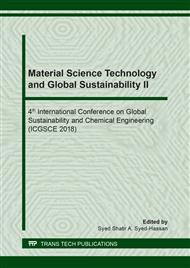p.299
p.309
p.319
p.327
p.336
p.342
p.351
p.359
p.365
Aspen Plus Simulation of Bio-Char Production from a Biomass-Based Slow Pyrolysis Process
Abstract:
Biomass-based pyrolysis is a thermo-chemical conversion of biomass feedstock with low oxygen supplied level to produce bio-char, bio-oil and bio-syngas products via slow, intermediate and fast pyrolysis, respectively. The specific yields from pyrolysis process depend on operating conditions to maximize outputs. Bio-char can be used as soil improvement, animal feed supplements, filter material, carbon storage, and energy source. This study has focused on the development a simulation model for slow pyrolysis process utilizing biomass from oil palm empty fruit bunches (EFB) in Aspen Plus software. The facts that EFBs are abundant in Malaysia and have huge feedstock potentials could be realized, among them, through process design dan analysis in the Aspen Plus. Simulation model was developed based on EFB proximate and ultimate analyses and aimed for optimal product fraction yields and for the elemental composition of the pyrolysis products, considering several factors or effects such as pyrolysis temparature, pressure and inert gas flowrate. Simulation results showed the optimal value of bio-char yield was 68.6 wt. % at 9 bars, 300 °C, and 0.1 kg/min of inert gas flow rate. Eventhough the developed simulation model was an equilibrium-based one, it is useful especially in determining the optimal values of the key effects for the slow pyrolysis process.
Info:
Periodical:
Pages:
336-341
Citation:
Online since:
March 2019
Keywords:
Price:
Сopyright:
© 2019 Trans Tech Publications Ltd. All Rights Reserved
Share:
Citation:



